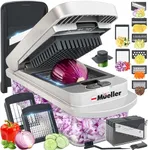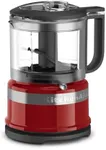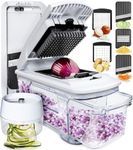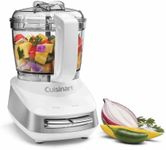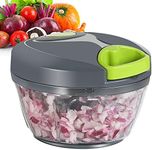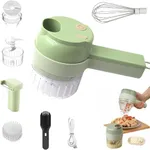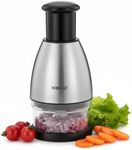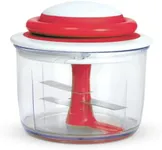Buying Guide for the Best Manual Food Choppers
Manual food choppers are a great kitchen tool for quickly and efficiently chopping, dicing, and mincing a variety of foods without the need for electricity. They are perfect for those who want to save time on food prep and prefer a more hands-on approach. When choosing a manual food chopper, it's important to consider several key specifications to ensure you select the best fit for your needs. Here are the main specs to look out for and how to navigate them.Blade MaterialThe blade material is crucial because it determines the sharpness, durability, and ease of maintenance of the chopper. Stainless steel blades are the most common and preferred choice as they are rust-resistant, maintain sharpness for a long time, and are easy to clean. If you plan to use the chopper frequently and for a variety of foods, stainless steel is the best option. For occasional use, other materials like plastic or ceramic might suffice, but they may not offer the same durability.
CapacityCapacity refers to the amount of food the chopper can hold at one time. This is important because it affects how much food you can process in one go. Small choppers with a capacity of around 1-2 cups are suitable for single servings or small tasks like chopping herbs or nuts. Medium choppers with a capacity of 3-4 cups are ideal for small families or moderate food prep. Large choppers with a capacity of 5 cups or more are best for larger families or those who do a lot of cooking and need to process larger quantities of food at once. Choose a capacity that matches your typical food prep needs.
Operation MechanismThe operation mechanism refers to how the chopper is powered and operated. There are different types, including pull-cord, push-down, and rotary choppers. Pull-cord choppers use a string mechanism to spin the blades and are great for quick, efficient chopping. Push-down choppers require you to press down on the top to chop the food, offering more control over the chopping process. Rotary choppers use a hand-crank to rotate the blades and are ideal for those who prefer a more traditional approach. Consider your comfort and ease of use when choosing the operation mechanism.
Ease of CleaningEase of cleaning is an important factor because it affects how much effort you need to put into maintaining the chopper. Look for choppers that are dishwasher safe or have easily removable parts that can be washed separately. Some choppers come with cleaning tools or brushes to help remove food particles from the blades. If you plan to use the chopper frequently, choosing one that is easy to clean will save you time and effort in the long run.
Safety FeaturesSafety features are important to prevent accidents and ensure safe operation. Look for choppers with non-slip bases to keep the chopper stable during use. Blade guards or covers are also essential to protect your fingers from the sharp blades when not in use. Some choppers have locking mechanisms to keep the lid securely in place while chopping. If you have children or plan to use the chopper frequently, prioritize models with robust safety features to minimize the risk of injury.
VersatilityVersatility refers to the range of functions the chopper can perform. Some manual food choppers come with interchangeable blades or attachments that allow you to slice, dice, mince, and even spiralize vegetables. If you want a multi-functional tool that can handle various tasks, look for a chopper with multiple blade options and attachments. For those who only need a chopper for basic tasks, a simpler model with fewer features may be sufficient.
